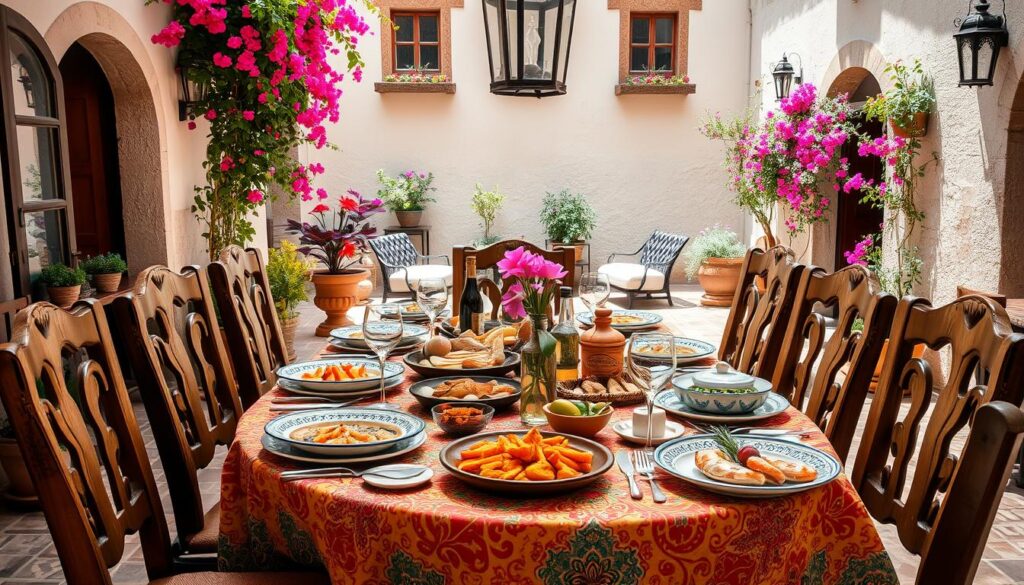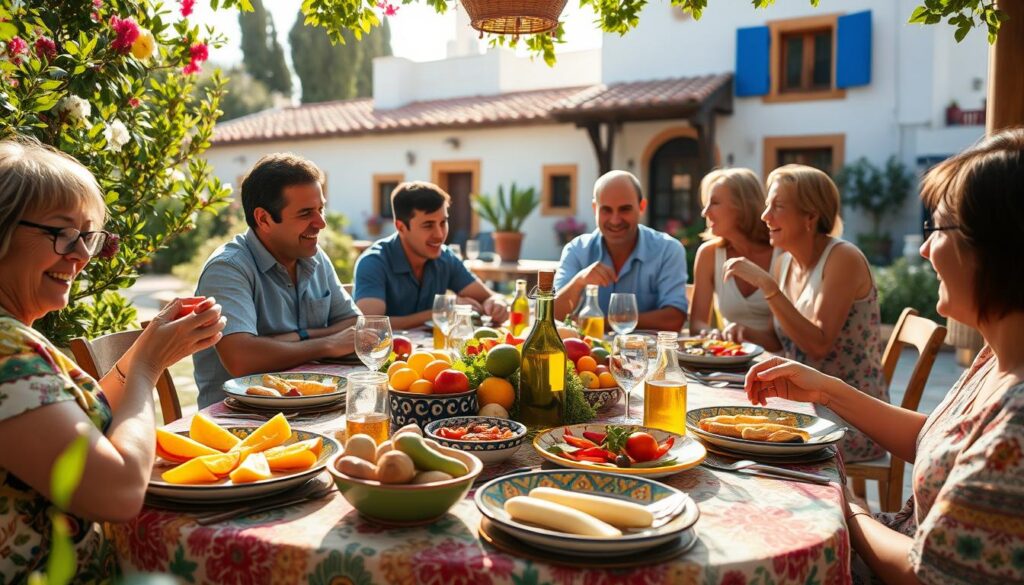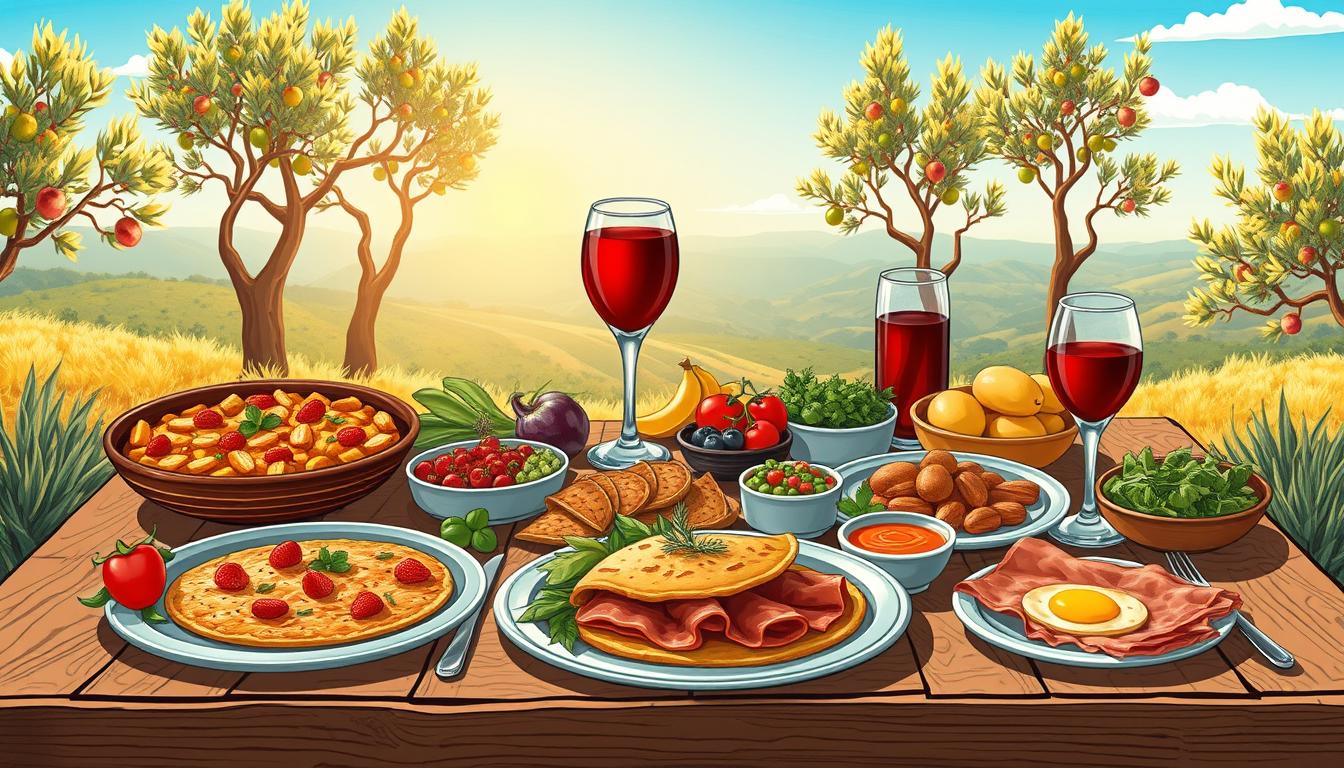Ever found yourself hungry in Madrid, trying to order lunch but struggling with Spanish? I remember my first trip to Barcelona. My attempts to say “lunch in Spanish” ended in a funny show with confused restaurant staff.
Exploring Spanish mealtime words can be an exciting journey. Learning the right phrases isn’t just about talking. It’s about diving into a world where lunch is more than food—it’s a lively social event.
This guide will help you understand lunch in Spanish. You’ll be able to order confidently, know what’s on the menu, and enjoy Spanish food like a local. From simple phrases to local customs, you’ll soon be speaking Spanish lunch like a pro.
Table of Contents
Key Takeaways
- Mastering basic Spanish lunch vocabulary enhances travel experiences
- Different Spanish-speaking regions have unique mealtime traditions
- Understanding cultural context is as important as language skills
- Lunch in Spanish culture is more than just eating – it’s a social event
- Pronunciation and confidence matter more than perfect grammar
Understanding Basic Spanish Meal Terms
Exploring Spanish cuisine starts with knowing key meal terms. These terms are more than just words. They show the culture and traditions of Spanish-speaking areas.
Common Words for Different Meals
In Spanish, meal words change a bit by region. Here are the main terms you’ll find:
- Desayuno: Breakfast – usually light and early
- Almuerzo: Lunch – the biggest meal of the day
- Cena: Dinner – a lighter meal in the evening
Regional Variations in Meal Names
Spanish-speaking countries have interesting differences in meal names. Some places have extra terms that might surprise you.
| Region | Lunch Term | Cultural Note |
|---|---|---|
| Spain | Comida | Midday meal lasting 2-3 hours |
| Latin America | Almuerzo | Shorter lunch break, more work-focused |
Time-specific Meal Vocabulary
Knowing meal terms by time can make dining better. Phrases like el menú del día (today’s menu) and un menú de precio fijo (fixed-price menu) help you at restaurants.
“Language is the road map of a culture. It tells you where its people come from and where they are going.” – Rita Mae Brown
The Bureau of Labor Statistics says 25.9% of restaurant workers are Hispanic or Latino. This shows how key it is to grasp these culinary terms.
Lunch in Spanish: Essential Vocabulary
Exploring lunch in Spanish can change how you enjoy meals. The main word for lunch is almuerzo. But comida is used in different places too. Knowing these words makes eating out easier.
Here are some important lunch terms to improve your Spanish:
- La carta – Menu
- Plato principal – Main course
- Postre – Dessert
- Bebida – Drink
- Entrada – Appetizer
But, lunch words can vary by region. In Mexico, comida means lunch. Yet, in other places, almuerzo is more usual. Knowing these differences helps you talk better.
“Language is the road map of a culture. It tells you where its people come from and where they are going.” – Rita Mae Brown
Here’s a quick guide to help you learn lunch words:
| Spanish Term | English Translation | Usage Region |
|---|---|---|
| Almuerzo | Lunch | Most Latin American Countries |
| Comida | Meal/Lunch | Mexico, Spain |
| Menú del día | Daily set menu | Spain |
Remember, how you use these words matters. Talk with native speakers to get better at saying these lunch words in Spanish.
Spanish Restaurant Phrases for Lunch Time
Exploring a Spanish restaurant is an exciting adventure. Learning key phrases boosts your confidence and makes dining better. Whether in Spain or a local Latin restaurant, these phrases help you communicate well.
Learning Spanish dining expressions is more than just translation. It’s about understanding cultural nuances and connecting with local traditions.
Making Reservations
Booking a table needs specific phrases. Here are the essential ones:
- Quisiera hacer una reserva – I’d like to make a reservation
- ¿Tienen una mesa para dos? – Do you have a table for two?
- A qué hora puede ser? – What time is available?
Ordering Your Meal
Ready to order? Use these phrases:
- Quiero… – I want…
- Me gustaría… – I would like…
- Para mí… – For me…
Don’t forget to say ¡Buen provecho! (Enjoy your meal) to show respect for local customs.
Asking for the Check
Finished dining? Use these phrases to ask for the bill:
- La cuenta, por favor – The check, please
- Estoy listo para pagar – I’m ready to pay
“Language is the road map of a culture. It tells you where its people come from and where they are going.” – Rita Mae Brown
Learning these phrases not only helps you order food. It also shows respect for Spanish-speaking countries’ rich culinary traditions.
| Phrase Type | Spanish | English Translation |
|---|---|---|
| Reservation | Quisiera hacer una reserva | I’d like to make a reservation |
| Ordering | Me gustaría | I would like |
| Paying | La cuenta, por favor | The check, please |
Popular Spanish Lunch Dishes
Exploring Spanish lunch dishes reveals a world of flavors. Each region in Spain has its own special dishes. These dishes reflect the country’s rich culture and local ingredients. Let’s explore some popular Spanish foods that will excite your taste buds.
Spain has a wide range of lunch options. The menú del día (daily menu) is a great way to try real Spanish food. Here are some dishes you must try:
- Paella Valenciana: A famous rice dish from Valencia, with seafood, chicken, or rabbit
- Tortilla Española: A classic potato omelet enjoyed at any time
- Gazpacho: A cool tomato soup perfect for hot days
- Gambas al Ajillo: Delicious garlic shrimp in clay pots
Each region in Spain has its own special dishes. These dishes show the country’s rich culinary diversity.
| Region | Signature Lunch Dish | Key Ingredients |
|---|---|---|
| Andalusia | Gazpacho | Tomatoes, cucumber, peppers, olive oil |
| Valencia | Paella | Rice, saffron, seafood or meat |
| Basque Country | Pintxos | Small appetizers, varied ingredients |
“In Spain, lunch is not just a meal—it’s a cultural experience that brings people together.” – Spanish Culinary Expert
Lunch in Spain usually starts at 2 PM and can last until 4 PM. Many restaurants offer special lunch menus. These menus are affordable and let you try many dishes. Your journey through Spanish lunch dishes will be both tasty and unforgettable!
How to Order Lunch in Different Spanish-Speaking Countries
Ordering lunch in Spanish-speaking countries is an exciting adventure. Each place has its own customs and flavors. This makes exploring regional Spanish cuisine a thrilling journey for travelers and language lovers.
Knowing local dining traditions helps you order lunch with confidence. It lets you dive into the culture. Let’s look at how different Spanish-speaking regions order lunch.
European Spanish Customs
In Spain, lunch is more than food—it’s a time to socialize. People often enjoy tapas or raciones (shared plates) at midday. Here are some tips:
- Learn to use the verb “tomar” correctly when ordering
- Be prepared for late lunch times (around 2-3 p.m.)
- Expect communal dining and sharing dishes
Latin American Variations
Latin American countries have their own ways of ordering lunch. Many places offer a menu del día (set lunch menu). This is a great way to try authentic food affordably. Each country has its own specialties, like:
- Argentina: Famous for asado (grilled meats)
- Peru: Known for ceviche and seafood dishes
- Colombia: Offers diverse regional specialties
Regional Specialties
When ordering lunch, learn about local specialties. Each area has unique dishes that show its culinary heritage. Try saying “¿Cuál es la especialidad del día?” (What is today’s specialty?) to find out what’s popular.
“Knowing how to order confidently transforms a simple meal into a cultural experience.” – Travel Language Expert
Practice and cultural awareness are key to ordering lunch in Spanish-speaking countries. Embrace the variety of regional Spanish cuisine and enjoy your food journey!
Spanish Dining Etiquette and Customs
Learning Spanish dining etiquette can make your meals in Spanish-speaking countries better. It’s not just about what you eat. It’s about joining a tradition that values food and friendship.

In Spain, there are important table manners to know. Before you start, say “buen provecho” (enjoy your meal). This is a polite way to show respect for the mealtime.
- Keep hands visible on the table during meals
- Use utensils in the European style (fork in left hand, knife in right)
- Wait for the host to begin eating before starting your meal
- Avoid placing elbows on the table
“Dining in Spain is not just about food, but about creating connections and enjoying shared moments.” – Spanish Cultural Expert
Meal times are key in Spanish dining. Lunch is the big meal, from 2:00 to 4:00 PM. Dinners are later, starting after 9:00 PM. This shows a relaxed attitude towards eating.
| Meal Time | Typical Hours | Cultural Significance |
|---|---|---|
| Breakfast (Desayuno) | 7:00 – 9:00 AM | Light meal, often coffee and pastry |
| Lunch (Comida) | 2:00 – 4:00 PM | Main meal of the day, social gathering |
| Dinner (Cena) | After 9:00 PM | Later, lighter meal with social emphasis |
Tipping in Spain is not required, but a small extra for great service is nice. By following these dining rules, you’ll enjoy your meals more and connect with the local culture.
Essential Phrases for Dietary Restrictions
Going to Spanish restaurants can be tough if you have special dietary needs. Knowing key phrases for dietary restrictions in Spanish makes it easier. It helps you enjoy your meal safely and communicate well.
Allergies and Food Sensitivities
It’s important to talk clearly about food allergies in Spanish. Here are some essential phrases to keep you safe:
- Soy alérgico/a a… (I’m allergic to…)
- Tengo una alergia a… (I have an allergy to…)
- ¿Contiene este plato… (Does this dish contain…)
Vegetarian and Vegan Options
Spanish food has many vegetarian options. Here are some phrases to help you find them:
- Soy vegetariano/a (I’m vegetarian)
- Soy vegano/a (I’m vegan)
- ¿Tiene opciones vegetarianas? (Do you have vegetarian options?)
Special Meal Requests
Here are some phrases to ask for special meals:
- ¿Puede preparar esto sin… (Can you prepare this without…)
- Sin gluten (Gluten-free)
- Sin lácteos (Dairy-free)
“Communication is key when managing dietary restrictions in a foreign country.”
| Dietary Need | Spanish Phrase | English Translation |
|---|---|---|
| Allergic to nuts | Soy alérgico/a a los frutos secos | I’m allergic to nuts |
| Vegetarian meal | Necesito un plato vegetariano | I need a vegetarian dish |
| Gluten-free | Necesito algo sin gluten | I need something gluten-free |
Most Spanish restaurants are very helpful. They will find you a meal that fits your needs. Practice these phrases to have a great dining experience.
Understanding Spanish Lunch Time Culture

Explore the world of Spanish lunch culture, where meals are more than food. They are cherished social experiences. The Spanish turn midday dining into an art form, going beyond just eating.
The siesta is at the heart of Spanish lunch culture. It’s a midday break that shapes daily life. Lunch starts around 2 PM and can last until 4 PM. It’s the biggest meal of the day, a time for families and colleagues to come together.
“In Spain, lunch is not a meal, it’s a celebration of life and connection.”
Spanish lunch traditions include:
- Multiple courses for a leisurely dining experience
- Social interaction is key during meals
- Time spent enjoying food and conversation is extended
- Menu del Dia (fixed-price lunch menu) is a favorite
The Spanish lunch usually has:
- A starter, often soup or salad
- Main course with protein
- Dessert or coffee
- Optional wine or refreshment
Learning about Spanish mealtime traditions helps travelers appreciate the cultural approach to dining. It’s not just about food. It’s about connection, relaxation, and enjoying life’s simple pleasures.
Tips for Navigating Spanish Restaurant Menus
Understanding Spanish restaurant menus can seem tough at first. But, with the right Spanish food vocabulary, you’ll get the hang of it quickly. Knowing Spanish menu terms is essential for a true dining experience in Spanish-speaking countries.
- Entrantes (Starters): Appetizers and small plates
- Platos principales (Main Courses): Primary dishes
- Postres (Desserts): Sweet endings to your meal
Look for special keywords that describe cooking methods and dish characteristics. Some helpful Spanish menu terms include:
| Term | English Translation | Meaning |
|---|---|---|
| A la plancha | Grilled | Indicates grilled preparation |
| Frito | Fried | Indicates deep-fried dishes |
| Especialidad de la casa | House specialty | Restaurant’s recommended dish |
Pro tip for reading Spanish menus: Don’t hesitate to ask the server about unfamiliar terms. Most restaurant staff appreciate customers who show interest in learning about their cuisine.
“Language is the road map of a culture. It tells you where its people come from and where they are going.” – Rita Mae Brown
By familiarizing yourself with these Spanish menu terms and phrases, you’ll navigate restaurant menus with confidence. You’ll also enjoy a more immersive dining experience.
Conclusion
Your Spanish lunch guide is more than just learning words. It’s about diving into a vibrant cultural world. By learning about Spanish food culture, you open up to real connections with local people. The skills you’ve gained will turn your dining experiences into deep, memorable moments.
Learning to speak Spanish in restaurants takes patience and a true interest in the culture. Every time you order food, whether in Mexico City or Barcelona, you grow more confident. Remember, learning a language is a journey, not a goal. Your openness to try, make mistakes, and learn will help you a lot.
The words, phrases, and cultural tips you’ve picked up are great for exploring different food scenes. You can now enjoy meals with real appreciation, knowing about local customs and how to ask for special dishes. See every meal as a chance to connect, learn, and enjoy the rich traditions of Spanish-speaking areas.
Keep practicing, stay curious, and let your love for language and food lead the way. Your Spanish food journey is just starting, filled with tasty finds and cultural exchanges that go beyond just eating.

